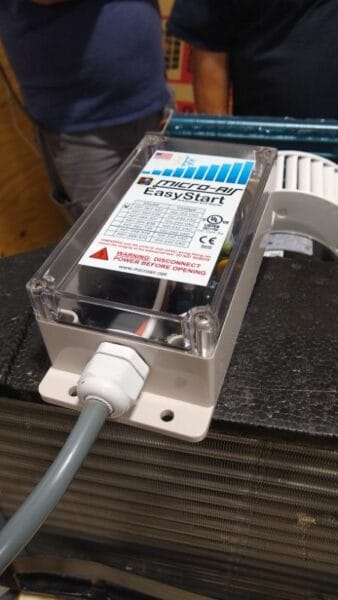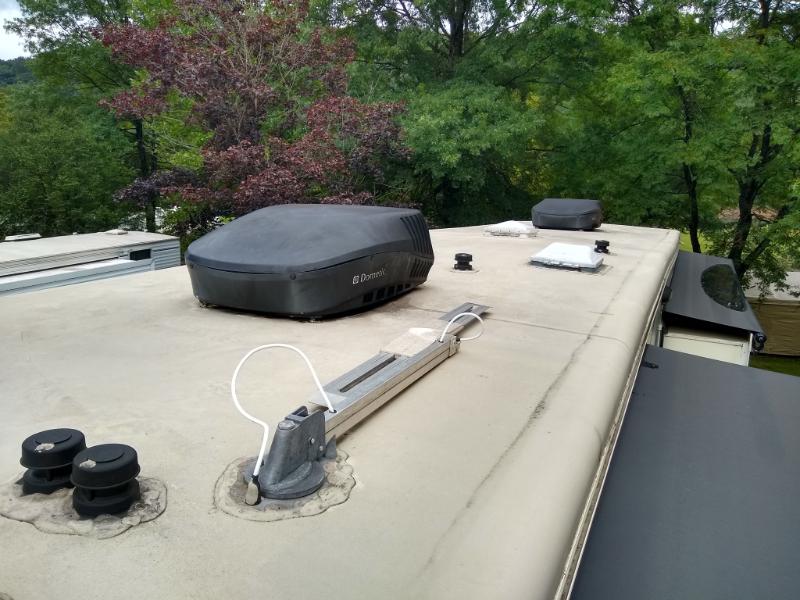I’m targeting a certain kind of RV owner with this post. If you searched, “Can I run two air conditioners with Soft Starts?” then I’m betting you own a 50-amp RV with two or three air conditioners. You’re wondering how you can manage to run two air conditioners off a 30-amp connection, and you’re hoping the Soft Start will do the trick.
Well … it just might! But you’ll need a Soft Start for each air conditioner.
What Is An RV Soft Start Work?
“Soft Start” is like the term “Bandaid” or “Kleenex.” It’s an eponym for several similar products, like the Network RV SoftStartRV, the Micro-Air Easy Start, the Spartan Power SpartanStart, and several other products.

All of these products do something similar: They reduce the surge of current required to start the compressor of an RV air conditioner. Most modern Soft Starts are “smart” devices that both self-optimize and self-diagnose. They’re pretty nifty!
Why Would I Need an RV Soft Start?
We will avoid heavy-duty physics, but take it from me that inductive electrical loads, like A/C motors and compressors, require a lot of current when they first turn on. As you can see in the graph below (not necessarily representative), there’s a huge peak inrush current, followed by a fast decay. This all happens within fractions of a second, but it’s still a lot of energy.

The initial spike in inrush current can be 10-20 times the normal running current of the compressor, but it only lasts for a few AC cycles. It quickly decays to the Locked Rotor Current (LRC), which is still 3-8 times higher than normal (commonly 40-80 amps). Once the compressor is up to speed, it will only draw the running current for that load. Air conditioner compressors do draw more current as ambient temperature increases, but that’s for another article!
The takeaway: All air conditioner compressors draw immense current (amps) during start-up. This inrush current can easily trip a thermal-magnetic circuit breaker, and that’s the whole reason for a Soft Start.
A Soft Start allows you to turn on an air conditioner without tripping the breaker. This is a common problem when trying to run air conditioners off a 30-amp power supply.
How Does an RV Soft Start Work?
So here’s how an RV Soft Start Works:
A Soft Start smooths out the compressor’s startup period by modulating the compressor voltage. By limiting the instantaneous voltage delivered to the motor, it reduces peak inrush current by up to 70%. So instead of an RV air conditioner drawing, say, 60 amps during inrush (which will often trip the 20-amp branch circuit breaker or the 30-amp main breaker), it only draws 35 amps for a split-second, which won’t trip the circuit breaker.*
*Even though the inrush current is technically over the breaker rating, all thermal magnetic circuit breakers have a trip curve; most don’t trip instantaneously once their nominal rating is exceeded. See the educational video below for more information:
There you go. That’s the magic. And Soft Starts are not unique to RVs. They are commonly used in marine applications as well.
3 Big Myths about RV Soft Starters
Myth: Doesn’t a Soft Start Decrease My Air Conditioner’s Running Amps?
Soft Starts do not – I repeat, DO NOT – reduce the running amps of your RV air conditioner at steady state. They are only in the circuit for a few tenths of a second before they switch themselves off. If your air conditioner normally draws 13.6 amps when running at 85 degrees, then installing a Soft Start WILL NOT CHANGE THAT. The device only changes the startup behavior of a compressor!
Myth: Isn’t an RV Soft-Start Just a Fancy Capacitor?
As a humble MechE, I am not the guy to fully explain the differences between a capacitor and a Soft-Start.
I will say that a run capacitor is a fairly rudimentary device with the primary purpose of A) starting a compressor in the correct direction and b) smoothing out the torque curve of a single-phase A/C compressor.
Meanwhile, a soft-starter device trades amps for volts, transforming the spiky current waveform of the startup period into a mostly linear power delivery. They usually do this with some incredible devices called silicon-controlled rectifiers (SCRs), but that’s where my knowledge gets fuzzy … But no, a Soft Start uses some pretty fancy electronics to modulate the inrush current, not just a capacitor.

Myth: Isn’t a Soft Start Just a Hard Start Kit By Another Name?
No, they are different products for different applications. In HVAC, a “hard-start” is a kit comprised of a starting capacitor and a start relay. They do the opposite of a Soft Start; they increase inrush current to bring the compressor quickly up to full power, which protects the compressor when high initial torque is required. Soft Starts trade more torque for less power, which is the more common problem facing RVs.
So Can I Run Two Air Conditioners Off a 30-Amp Hookup?
Ok, so here me out: You might be able to run two air conditioners off a single 30-amp connection AND two Soft Starts. If they are 11k or 13.5k BTU air conditioners, you’ve got a good chance. If you have energy-efficient air conditioners like the Coleman-Mach PowerSaver series, even better.
Again, Soft Starts DO NOT reduce the running amp requirements. If you have 15k BTU air conditioners drawing 16 amps each on average, a Soft Start will not help you run 2×16-32 amps off a 30-amp power supply. The math doesn’t work like that.
But you should be able to turn on two smaller (11k or 13.5k BTU) air conditioners without tripping your circuit breaker in most conditions. Here are some best practices:
- Install a Soft Start device on each air conditioner.
- Don’t mix and match brands.
- Don’t turn on both air conditioners simultaneously.
- Consider running each A/C on Low or Medium cooling mode to reduce the power draw.
- Keep your A/C coils clean for maximum efficiency!
- Be kind to your air conditioner by reducing heat gain!
Leave a Reply